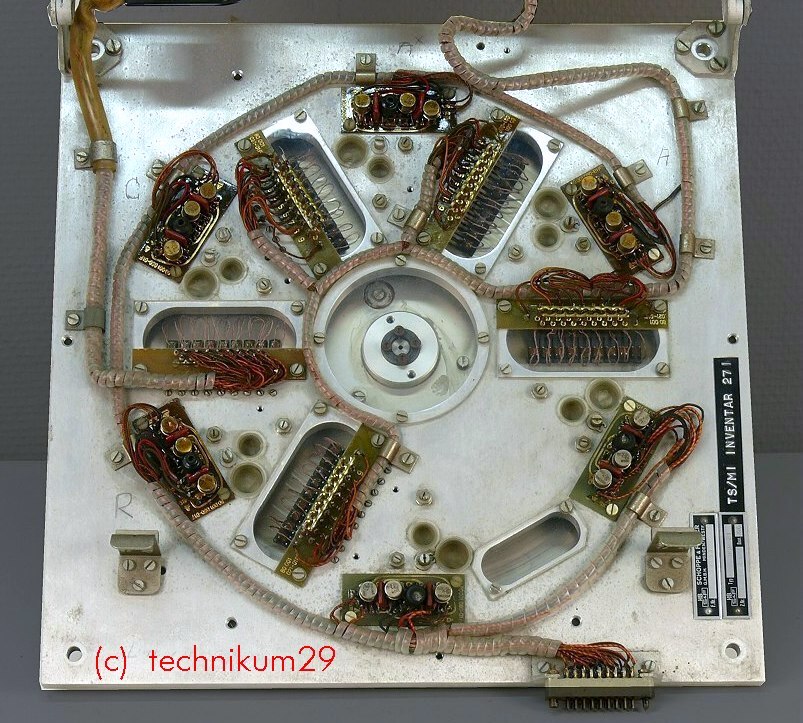Mini-computers

Today's kids think of the latest mobile devices when talking about "mini computers".
In contrast, in the 1960s and the early 70s, a computer was always huge (like our
UNIVAC mainframe), thus a 300kg computer was "mini".
Early computers are well worth seeing due to their enormous size and the nice
transparent auxillary devices.
There is a very important computer family that finally lead to (today's)
personal computers: The development of the "Mini" computers from Digital Equipment
Corporation (DEC), series PDP-8 and PDP-12 (both 12-bit architecture). The museum
owns a complete production run from that devices: From the PDP-8 (also called
Classic-8), year of manufacture 1965 to the PDP-8a (1975, this one is less
important so it is located in the archive). PDP means Programmed Data Processor.
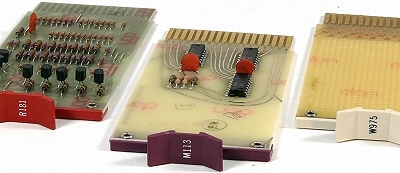
The manuals of these computers are very detailed, with full circuit documentation. There never have been any other computer with such an elaborate documentation. For restoration purposes these manuals are indispensable. Even in those days, other manufacturers kept their blueprints in secret for fear of unauthorized re-use (e.g. HP).
For further reading see the story about Rise and Fall of DIGITAL (Equipment Corporation).
Schoppe & Faeser: LGP-21 (General Precision)
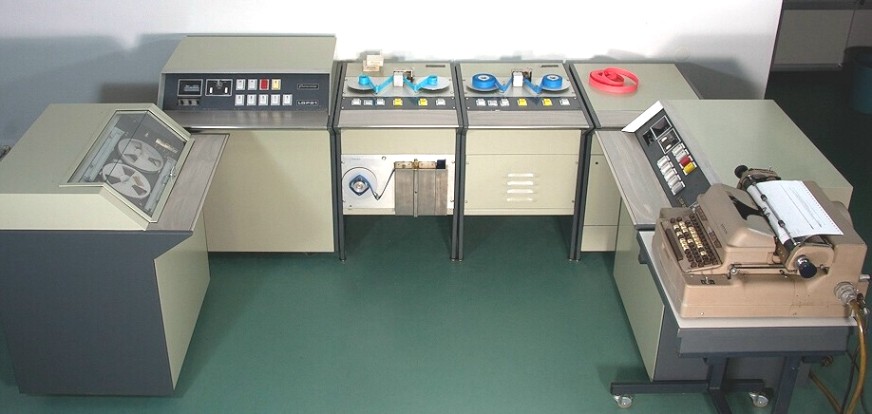
From left to right: magnetic tape drive, 1. LGP-21, Tally paper-tape-reader and punch, 2. Tally reader, two additional hard drives, 2. LGP-21, Flexowriter
This machine is particularly interesting in more than one way: 1) The hardware
is extremely simple, 2) the machine already employs a bus system for
interconnecting the various units. 3) The machine features a fixed disk which
holds all registers as well as timing tracks. As the picture above shows we
have two complete systems which simplifies troubleshooting and repair.
Citing from the original brochure (1964): "The LGP-21 is produced by Schoppe &
Faeser as a licensee in Europe and is distributed by EUROCOMP GmbH."
The LGP-21 had been developed by Librascope, division GP1 (USA). This company
once was one of the largest calculating machine manufacturers in the world.
Starting in 1962 the LGP-21 was marketed in the USA by General Precision. The
machine is a very small computer but was advertised as "The first complete
program controlled digital computer for only $16,250 in the minimum
configuration." This configuration consisted of the CPU and a Flexowriter only.
This machine was the successor of the LGP-30 (1st generation, 1956, also build
by Schoppe & Faeser in Germany as a licensed product). The LGP-21 is very rare
- only about 100 machines were built in Germany. Even rarer is the magnetic
tape unit of which only 5 known units were built. The machine in the museum has
serial number 4.
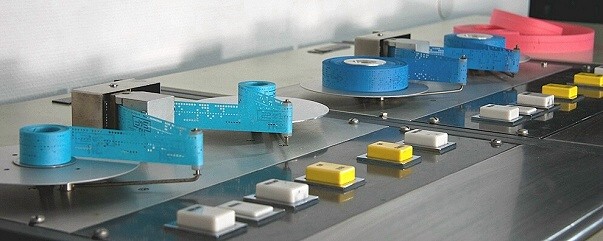
The external memory of the LGP-21 are perforated papertapes, which are scanned mechanically of the Tally-tape reader. The magnetic tape drive and other external drives were added in the late 60s.
As external storage the LGP-21 employs a paper tape system using Tally
papertape readers. The magnetic tape unit and two external disks with a
capacity of about 8000 words each were added in the late 1960s.
A rotating disk serves as the machine's main memory and clock generator. It
rotates with 1475 RPM and holds 4096 words of 32 bits each which equals 12 kB,
a reasonable size back then.
The disk contains 64 data tracks, four timing tracks and tracks for three registers (accumulator, instruction register and counter register). The mean write density is about 10 Bit/mm (about 1/200th of today's disk drives).
The LGP-21 supports 23 different instructions - enough to program typical scientific applications.
Repairing the machine turned out to be quite a challenge. Having two machines of this type helps a lot. More information about this interesting and rare system will follow.
Classic PDP-8
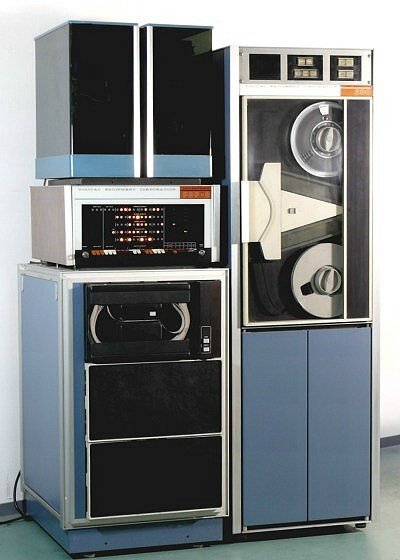
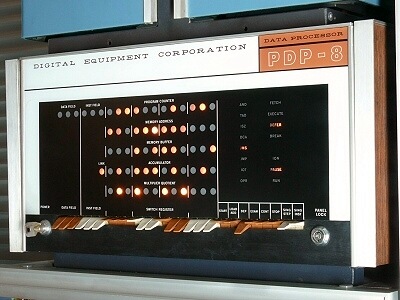
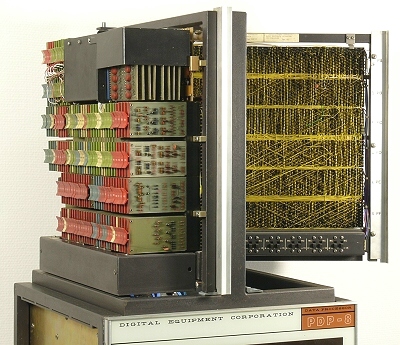
PDP computers were especially used by scientists. By using self-made
(CPU) interface boards, already existing (experimental) equipment could easily
migrated to the new hardware. DEC even offered prefabricated boards to
encourage own extension development.
The figure above shows a typical second generation module (1965) without ICs
from the classic PDP-8 on the left. In the middle is a smaller third generation
module with ICs (from 1967) which was used in the PDP-8i, PDP-8L and PDP-12.
On the right is an empty module just suitable for being equipped by the
user for interfaces to own periphery.
One of the museum highlights: The complete PDP-8 system with processor,
a big tape deck TU-580 (originally belonged to the PDP-5, manufactured in 1963),
punch card reader/puncher PC-01, hard-disc DF-32 with immovable heads
and a teletype as printer. The Classic PDP-8 is considered the world's first mass-produced
"minicomputer". Due it's use of ICs, unlike its predecessors, it is considered
a second-generation computer.
This computer features various different logic and register modules. All logic
is only built with NAND and NOR gatters. Registers are constructed with flip-flop
circuits. The extensive wiring of the modules (see picture) is called
Wire wrapping. This kind of
connections were used in all bigger computers until the 1980s, since it is an
easy way to connect two points which are not mounted on the same board or on the
same level. In the early days this wiring was manually performed and later executed
by machines. Even today there are still some wire-wrap-connections in testing
environments.
The picture shows the uncovered computer with opened right wing where you can easily
see the wire-wrap connections.
Top: Complete PDP-8 system,
center: console of the computer
below: open computer, the right wing is extended. Here you can see the wire-wrap connections.
The processor and the tape reader are on loan from the "FITG", Frankfurt (Germany)
PDP-8I
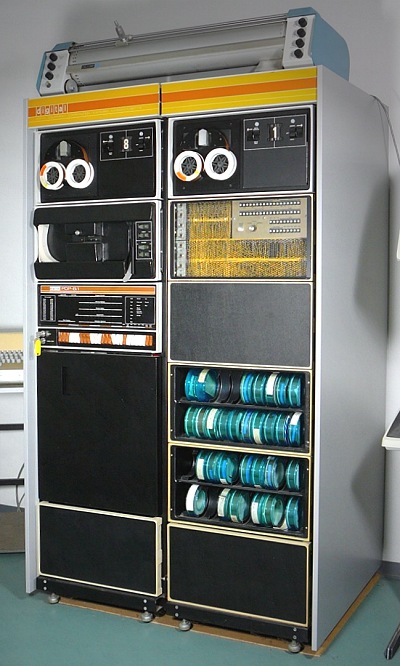
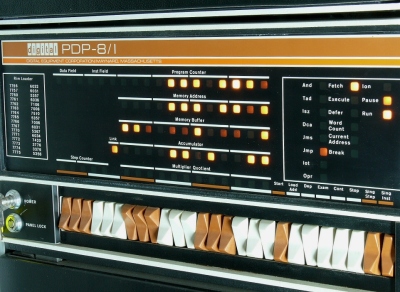
Left: The PDP-8i system with two-DECtapes TU 55, hight-speed paper tape reader/punch PC 04, 563 CALCOM plotter (top) and a TELETYPE (not shown). Above: the computer console
In 1967 the first series 74xx TTL ICs (transistor-transistor logic) came on the market.
DEC was at the bleeding edge, releasing the 8i ("with integrated circuits"). No one
knew about the stability of the new ICs (later bugs). Therefore UNIVAC used the well established
DTL technology even two years after. Fortunately, the TTL ICs proved to be as stable as the DTL
series. Since the integration degree was much higher, less space has been needed for computers.
DEC's first calculator with integrated circuits was very expensive. The CPU on alone
(in the picture: Left case, middle) cost US$ 27,000 without peripherals at that time.
The main memory had a capacity of 8kB. While computing a "large" problem, it was possible to swap
programs or data to files on magnetic tape and read in afterward be reread. DEC developed
an intelligent operating system (OS/8) which worked very efficiently with such little memory.
It is very interesting to watch this computer working.
If you have not been in the presence of this computer, you should know that it is quite large. With the plotter, it stands at a height of almost 7' (2m) and weighting at more than 600 lbs (300kg).
The peripherals consist of two TU-55 (tape drives), a PC-04 (high speed paper tape reader), Calcomp 563 plotter (at the top) and of course a teletype (not pictured).
PDP-8L
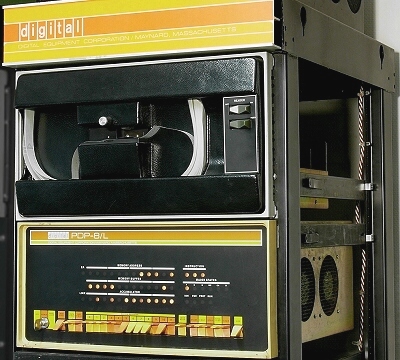
PDP-8L (build in 1968) with HSR Paper Tape Reader
Many DEC customers did not need the high memory capacity or installable options.
Therefore DEC developed the stripped-down computer PDP 8L (Low-cost) with
only a few pre-wired installed options in the lower price range.
The core memory had only 4kB capacity, it was extendable to 8kB with an external cabinet.
Our PDP-8L has many extensions: HSR (High Speed) paper tape reader, TC01 Tape Control
with two drives TU55 and additional memory.
DEC invented the interpreted programming language FOCAL (Formulating Online
Calculations in Algebraic Language), which allowed the user an interactive
programming environment (like a Unix shell). This language is similar to BASIC, but
slightly simpler. FOCAL required no operating system and ran smoothly with 4kB core
memory and lacking mass storage.
PDP-12, LAB-12
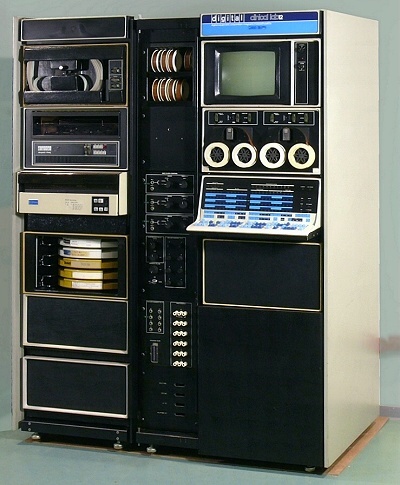
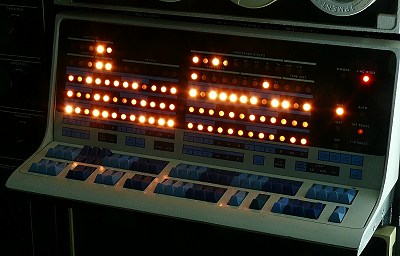
The PDP-12 was released in 1969. Just 755 units were sold worldwide. It was the last series that
could operate in LINC-Mode (it could be switched to either LINC
or PDP-8 Mode). This is a laboratory computer, equipped with AD and DA
converter as standard. Such computers were usually kept up to date
with hardware updates. The memory of this device was gradually
increased from 8kB up to 32kB (DW 08E storage extension).
Besides the tape drives, the computer was also equipped with
an 8-inch floppy drive. Afterwards they were removed again in
favor of two removable disk drives. Finally they even tied the
device to 10BASE-T ethernet, using a selfmade controller with an
handwritten TCP/IP stack on a selfmade operating system.
Thus this device can demonstrate the era from paper tapes up to
today's storage standard.
Check out the console in a large scale:
PDP-12 console (dark picture)
or: PDP-12 console (ligh picture)
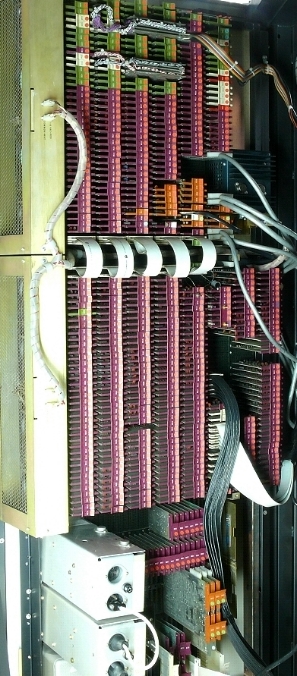
The picture on the left shows the PDP-12 inner life with all 462 Flip-Chip-Boards.
By having all the following options, our computer was very comfortable (the number in parentheses indicates the number of neccessary boards):
- AD12 [A-D-Control] (12 modules):
- The AD12 includes 16 channels of input, 10bit output resolution and features up to 60kHz signals at 30dB down.
- DM12 [Data Break Multiplexer for KF12-B] (6 modules):
- The DM12 provides the capability of operating up to three data break devices. The Data Break facility allows an I/O device to transfer information directly with the PDP-12 core memory on a cycle-stealing basis. This is particulary well suited for high-speed devices which transfer large amounts of information in block form. Peripheral I/O equipment could reach a maximum transfer rate of 6,5 Mbit/sec.
- DP12A [TTY-Dataphone] (4 modules):
- The DP12 options permit interfacing additional Teletypes and Modems. They are capable of accepting data asynchronously up to 100,000 baud. The units are designed for US-ASCII and meet the EIA-standard (RS232) requirements.
- DR12 [Relays and Control] (1 module):
- The relay buffer is a six-bit register connected to six relays that are mounted on the data terminal panel. They can be used for controlling experiments or external equipment not otherwise directly interfaced with the PDP-12 Computer. The states of the relays can be examinede at any time via the register.
- KE12 [Extended Arithmetik Element] (14 modules):
- The EAE enables the CP (the DEC operating system) to perform arithmetic operations at higher speed. The ALU is extended by asynchronous logic such as a 12-bit Multiplier Quotient Register and a 5-bit Step Counter. These components are used by auxillary CPU instructions (opcodes).
- KF12 [Multi Level] (54 modules):
- The Multi-Level Automatic Priority Interrupt is designed to reduce the CPU overhead during the servicing of program interrupts. Up to 15 levels of interrupts can be accomodated with each level having an unique vector address. The interrupts can be accepted from other options (CPU extensions) or from up to six external devices. Storing of priority and vectoring of interrupt service routines is performed with a Stack.
- KT12 [Time-Sharing Option] (2 modules):
- This module provides the additional logic circuits required for the PDP12 Time Sharing System. Having satisfied the minimum equipment, it perimts up to 16 users to operate their individual programs in an apperantly simultaneous manner. The system is controlled by a group of subprograms called "TSS/12 Monitor".
- KW12-A [Real Time Clock] (19 modules):
- The RTC can be used to generate Program Interrupts over a range of intervals of 2.5us to 40.96s; detect external and internal events in order to count them, measure them against a time base, measure the interval between them, use them as time base standard or control sample times of A/D conversions. In our system this module was used to connect the german longwave time signal radio station DCF77 in order to recieve the atomic clock time from the German master clocks in Frankfurt.
The computer is equipped with further cabinets which allow much more peripherals:
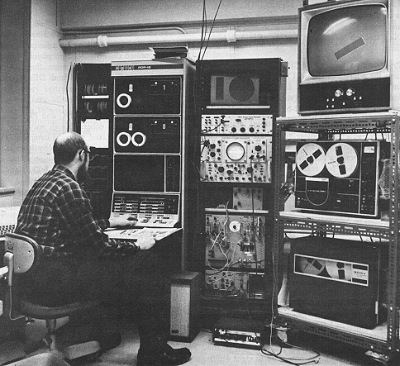
Typical picture in the 1970s: PDP-12 in the scientific domain. [Source: "digital products and applications, 1971"]
- AA50P [12 Bit DAC Controller]
- Cabinet to upgrade the number of digital-analog converters (half filled in our setup)
- BA12 [Peripharal Expander]
- Cabinet for peripheral extension, e.g. paper tape reader/puncher, PC05, card readers, etc.
- DW08A [I/O Bus Converter]
- Cabinet to connect "negative bus system" units. The "negative logic level" was used at the time of germanium transistors (PNP), for example the DF32 disk drive with fixed heads.
- DW08E [I/O Bus Converter]
- This plug-in for the smaller PDP-8e converts the PDP-8, -8i and -12 bus to the OMNIBUS system from the PDP-8e. Thus all 8e interfaces could be connected, e.g. the RK8E interface (Digitl RK05) or Plessey PM DD/8 disk drives.
- BM812 [Memory Expansion Box]
- Memory expansion box that is capable of expending either a PDP8i or PDP12 from 8kB to 32kB with MM8e-stacks (like in the PDP-8e).
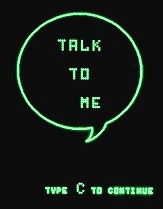
So logs the PDP-12-demo program
This system is fully developed. This was a common approach at that time: At first the
computer was purchased in the basic version which was barely affordable. Afterwards
more options were installed step-by-step. That way the enormous acquisition costs
were distributed over several years and the computer was always up to date.
We have very good programs [Demo-12 running on DIAL], which shows with extreme illustrative the performance of the computer. This includes an on-screen analog clock with real-time display and the game
"SPACE WAR". Some of will be soon available on our special page [in working].
(Google-translation!):We have a PDP-12 price list from the year 1973, a period in which the PDP-12 was already an outdated model. Our fully-equipped computer was a PDP-12 LDP (Laboratory Data Processor), here specifically a "clinical lab12", sold at a price of DM 206.700. Most of the options listed above were built in. (In 1973 3,50DM corresponds to 1$).
This computer was equipped with 4kB Memory Core. So one needs in adition a "Memory Extension Control" for 16.600 DM and a 4kB Memory Module for 25.100 DM. The price for the unimposing Peripheral Expander BA12 was 5.400 DM (equivalent to a midsize car) and "High-Speed Paper Tape Reader/Punch" incredible 16.200 DM.
A Disk Cartridge Drive RK05 where sold for DM 21.200, where one needs in addition the "Positive I/O Bus to Omnibus Converter" DW8E (6750 DM). Similarly is the Converter DW08A and the Cabinet AA50 for additional D/A Controller. The 3 plugged D/A modules were calculated with 1.680 DM per unit.
The memory expansion to 32K does not appear on the list, but the price for this option was about 50.000 DM including the controller.
In the sum it is a staggering number of 387.690 DM, which is today corresponding about 500,000 Euro or 600.000 $!
Lab-8e, PDP-8e
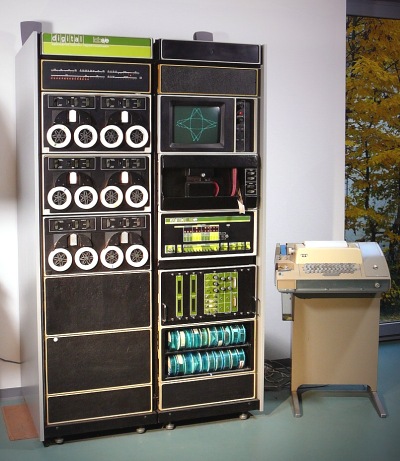
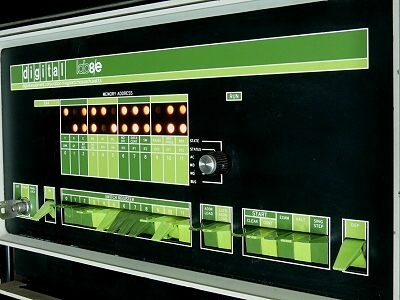
The successor of the PDP-8i was the PDP-8e (1970). This computer came with an internal bus system, so you could easily attach any peripherals using interface cards. This feature made the "mini"-computer all-purpose. This computer type was offered with diverse A/D- and D/A-converters and connection facilities as a laboratory computer for analogue devices (shown in the picture). The peripherals are:
- VR 12 (oscilloscope display)
- PC 04 (High speed paper tape reader/puncher)
- 3 x TU 56 (double tape drive)
- A/D- and D/A-converter
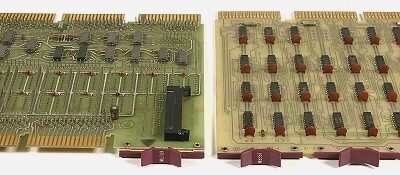
The picture on the left shows a board for own peripheral interfaces. In this unit, bus amplifiers, etc. are already mounted. You could install your own ICs in front of them and connect them with Wire-Wrap or soldered wires. On the right is a typical module with a lot of ICs. Both modules are only partially visible.
Data General: NOVA 2
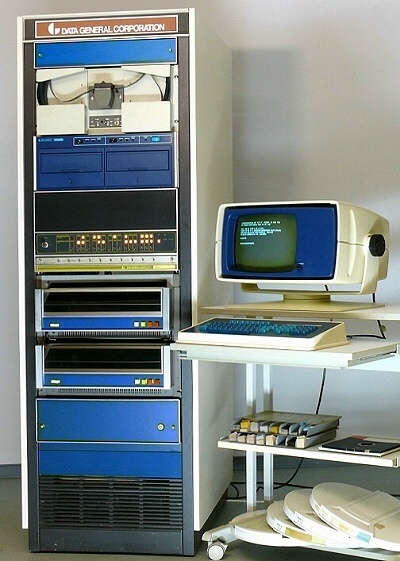
Edson de Castro was responsible for product management at DEC and was intent
on developing a 16-bit computer with a processor that would fit on a single
printed circuit board. But Ken Olson, the founder of DEC, wasn't
supportive. So de Castro left DEC in 1968 together with three other
hardware engineers to found his own company in a vacant barber's shop:
Data General Corporation (Massachusetts, USA).
Already in 1969 the first 16-bit computer in the "NOVA" series was ready
for the market. Thanks to the simpler production method (no wire wrapping,
only two boards + memory boards etc.) the basic version was quite inexpensive
at $4000. However, this basic model alone wasn't really that useful, and
after extending the computer the total price was substantially higher.
The Nova computer was advertised as "the best small computer in the world".
At this time, DEC was still building the PDP-8/I and the PDP-12, which
required lots of very small flip-chip-modules.
The successor model (available in 1973), the NOVA 2, was simplified even
further, and the increased chip density made it possible to have the whole
processor together with the control logic for slow peripheral devices
(teletype, paper tape puncher and reader) one single board. Our Nova is a
NOVA 2/10 model with slots for 10 boards, and therefore enough space for
quite a few device controllers and memory extensions.
From today's perspective, the rather huge boards (15x15 inch,
nicknamed "circuit graveyards in baking tray size") do have disadvantages:
any kind of repair is very difficult, because it is not possible to pin down
a malfunction by exchanging small boards.
The NOVA shown in the picture is from a university. It is equipped with
two harddisk drives, one twin floppy drive (8" disks!), one teletype,
one high-speed paper tape punch reader and one punch card reader (not in
the picture). Later on a terminal was added, which extended the computer
to a comfortably usable system.
Hardware configuration, from top to bottom:
- Paper tape punch reader (mostly used for testing programs included with
every delivered system)
- Twin disk drive for 8-inch floppy disks, Model 6032
- CPU with core memory, 32 KB, access time 0.8 us
- Two hard-disk drives with removable cartridges, Series 30. Capacity 1.200.000 16-bit words, or 2.4 MB.
- Disk Cartridge System 4047, necessary to connect the second disk
- Terminal "DASHER 1", Model 6052 by Data General, on the right hand side
- Twin disk drive for 8-inch floppy disks, Model 6032
